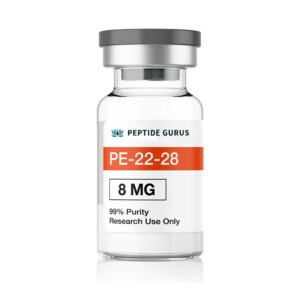In recent years, the
peptide PE-22-28 has emerged as a subject of scientific interest due to its multifaceted biological activities. While primarily studied for its neuroprotective and antidepressant properties, emerging research suggests its potential role in muscle function research. This article explores the mechanisms, preclinical findings, and regulatory considerations of PE-22-28 in muscle-related applications, presented in an accessible yet professional manner.
PE-22-28 is a synthetic analog derived from the naturally occurring peptide spadin, which targets the TREK-1 (TWIK-related potassium channel) receptor . Composed of 7 amino acids (sequence: GVS WGLR), it acts as a selective antagonist of TREK-1, a potassium channel involved in regulating cellular excitability. While TREK-1 is predominantly expressed in the brain, it is also found in skeletal muscles, heart, and other tissues .
The TREK-1 channel plays a critical role in muscle physiology. In skeletal muscle, TREK-1 activity influences the response to mechanical stimuli. Blocking TREK-1 with PE-22-28 has been shown to enhance muscle contractility, while activating the channel promotes relaxation . This mechanism suggests PE-22-28 could modulate muscle function in conditions like muscle weakness or impaired contractility.
- Enhanced Contractility: By inhibiting TREK-1, PE-22-28 may increase the excitability of muscle cells, leading to stronger contractions. This effect has been observed in vitro and in animal models, where TREK-1 blockade improved force generation in skeletal muscle tissue .
- Regulation of Calcium Handling: TREK-1 channels interact with calcium signaling pathways in muscle cells. PE-22-28’s inhibition of TREK-1 could optimize calcium release and reuptake, enhancing muscle fiber activation and recovery .
- Anti-Inflammatory Effects: Chronic inflammation contributes to muscle wasting. PE-22-28’s anti-inflammatory properties, observed in neuroinflammatory models, may indirectly support muscle health by reducing pro-inflammatory cytokines .

While limited, preclinical studies provide insights into PE-22-28’s potential in muscle research:
- Muscle Contraction: In isolated skeletal muscle preparations, PE-22-28 increased twitch tension and prolonged contraction duration, indicating improved contractile efficiency .
- Neuro-Muscular Junction: TREK-1 blockade by PE-22-28 enhanced neurotransmitter release at the neuromuscular junction, potentially improving signal transmission between nerves and muscles .
- Post-Stroke Recovery: In a mouse model of stroke, PE-22-28 improved motor coordination and reduced muscle weakness, suggesting benefits for post-stroke rehabilitation .
Cellular studies using muscle cell lines demonstrated that PE-22-28 increased the expression of myogenic markers (e.g., MyoD) and promoted myotube formation, indicating a role in muscle cell differentiation and repair .
PE-22-28 remains investigational and is not FDA-approved for human therapeutic use . To advance toward clinical applications, the peptide must undergo rigorous testing:
- Preclinical Safety: Studies evaluating toxicity, pharmacokinetics, and long-term effects in animal models are essential.
- Clinical Trials: Phase 1 trials would assess safety and tolerability in humans, followed by Phase 2/3 trials to evaluate efficacy in specific muscle conditions (e.g., sarcopenia, post-stroke weakness).
- Manufacturing Standards: Compliance with Current Good Manufacturing Practices (CGMP) ensures purity and consistency, critical for research and potential therapeutic use .
While PE-22-28 shows promise in enhancing muscle contractility in preclinical models, no human studies have evaluated its effects on athletic performance. It is not approved for sports-related use and should only be used under professional supervision in research settings .
In preclinical studies, PE-22-28 demonstrated a favorable safety profile, with minimal side effects like transient muscle soreness or mild inflammation. However, long-term effects in humans are unknown, and further research is needed .
PE-22-28 is typically administered via subcutaneous injection or inhalation in research settings. For muscle-specific applications, localized delivery (e.g., intramuscular injection) may be explored to target tissues directly .
